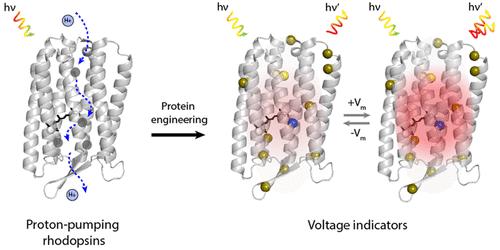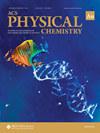电压成像与工程质子泵紫红质:从质子转移途径的见解
IF 3.7
Q2 CHEMISTRY, PHYSICAL
引用次数: 1
摘要
在过去的十年里,使用基因编码电压指示器(GEVI)的电压成像在神经科学领域掀起了一场风暴。其产生亚细胞和网络级电动力学读数的能力主要取决于所用指示剂对电压的响应动力学。工程微生物视紫红质形成了一个GEVI亚类,以其高电压敏感性和快速反应动力学而闻名。在这里,我们回顾了微生物视紫红质光循环的基本方面,这些方面对于理解这些蛋白质的电压敏感性机制至关重要,并将它们与创造更快、更亮、更敏感的基于微生物视紫红素的GEVI的努力联系起来。本文章由计算机程序翻译,如有差异,请以英文原文为准。

Voltage Imaging with Engineered Proton-Pumping Rhodopsins: Insights from the Proton Transfer Pathway
Voltage imaging using genetically encoded voltage indicators (GEVIs) has taken the field of neuroscience by storm in the past decade. Its ability to create subcellular and network level readouts of electrical dynamics depends critically on the kinetics of the response to voltage of the indicator used. Engineered microbial rhodopsins form a GEVI subclass known for their high voltage sensitivity and fast response kinetics. Here we review the essential aspects of microbial rhodopsin photocycles that are critical to understanding the mechanisms of voltage sensitivity in these proteins and link them to insights from efforts to create faster, brighter and more sensitive microbial rhodopsin-based GEVIs.
求助全文
通过发布文献求助,成功后即可免费获取论文全文。
去求助
来源期刊
CiteScore
3.70
自引率
0.00%
发文量
0
期刊介绍:
ACS Physical Chemistry Au is an open access journal which publishes original fundamental and applied research on all aspects of physical chemistry. The journal publishes new and original experimental computational and theoretical research of interest to physical chemists biophysical chemists chemical physicists physicists material scientists and engineers. An essential criterion for acceptance is that the manuscript provides new physical insight or develops new tools and methods of general interest. Some major topical areas include:Molecules Clusters and Aerosols; Biophysics Biomaterials Liquids and Soft Matter; Energy Materials and Catalysis

 求助内容:
求助内容: 应助结果提醒方式:
应助结果提醒方式:


